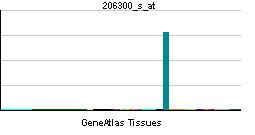Entrez 5744 | Ensembl ENSG00000087494 | |
 | ||
External IDs MGI: 97800 HomoloGene: 2113 GeneCards: PTHLH | ||
Parathyroid hormone-related protein (or PTHrP) is a protein member of the parathyroid hormone family. It is occasionally secreted by cancer cells (breast cancer, certain types of lung cancer including squamous cell lung carcinoma). However, it also has normal functions.
Contents
Function
PTHrP acts as an endocrine, autocrine, paracrine, and intracrine hormone. It regulates endochondral bone development by maintaining the endochondral growth plate at a constant width. It also regulates epithelial-mesenchymal interactions during the formation of the mammary glands.
Tooth eruption
PTHrP is critical in intraosseous phase of tooth eruption where it acts as a signalling molecule to stimulate local bone resorption. Without PTHrP, the bony crypt surrounding the tooth follicle will not resorb, and therefore the tooth will not erupt. In the context of tooth eruption, PTHrP is secreted by the cells of the Reduced Enamel Epithelium.
Mammary glands
It aids in normal mammary gland development. It is necessary for maintenance of the mammary bud. Loss of PTHrP or its receptor causes the mammary bud cell fate to change back into epidermis. In lactation, it may regulate in conjunction with the calcium sensing receptor the mobilization and transfer of calcium to the milk, as well as placental transfer of calcium.
Humoral hypercalcemia of malignancy
PTHrP is related in function to the "normal" parathyroid hormone. When a tumor secretes PTHrP, this can lead to hypercalcemia. As this is sometimes the first sign of the malignancy, hypercalcemia caused by PTHrP is considered a paraneoplastic phenomenon. PTHR1 is responsible for most cases of humoral hypercalcemia of malignancy.
PTHrP shares the same N-terminal end as parathyroid hormone and therefore it can bind to the same receptor, the Type I PTH receptor (PTHR1). PTHrP can simulate most of the actions of PTH including increases in bone resorption and distal tubular calcium reabsorption, and inhibition of proximal tubular phosphate transport.
However, PTHrP is less likely than PTH to stimulate 1,25-dihydroxyvitamin D production. Therefore, PTHrP does not increase intestinal calcium absorption.
Genetics
Four alternatively spliced transcript variants encoding two distinct isoforms have been observed. There is also evidence for alternative translation initiation from non-AUG (CUG and GUG) start sites, in-frame and downstream of the initiator AUG codon, to give rise to nuclear forms of this hormone.
Discovery
The protein was first isolated in 1987 by T.J. Martin's team at the University of Melbourne. Miao et al. showed that disruption of the PTHrP gene in mice caused a lethal phenotype and distinct bone abnormalities, suggesting that PTHrP has a physiological function.
Interactions
Parathyroid hormone-related protein has been shown to interact with KPNB1 and Arrestin beta 1.
